What is Microsoft 365 Sharepoint & Microsoft 365 Sharepoint Admin Center?
SharePoint is a document management and collaboration tool developed by Microsoft. It’s basically an intranet and content management system that is used for internal purposes to assist with bringing an organization together. On the later stage, the Microsoft Cloud version of SharePoint, SharePoint Online, has many additional integration capabilities with other cloud applications, and now it is part of Microsoft 365 solution.
Recent changes in Microsoft 365 allows many new features, centralized administrative capabilities, and new cloud-based web applications are added. Similarly, many new improvements are added in Microsoft Sharepoint Online, and a newly revamped administration portal launched for Microsoft 365 Sharepoint exclusively.
Table of Contents
- Sharepoint file activity report
- Sharepoint site usage report
- Message center
- Service health
- Sites – Active Sites & Deleted Sites
- Policies
- Sharing
- Access control
- Site creation
- Site storage limits
- Migration
- Conclusion
If you are a Microsoft 365 subscription Global administrator or privileged administrator, you can get more information on view, create and manage sites on Microsoft 365 Sharepoint Admin Center.
Access URL :
You can use Microsoft 365 Admin Center portal, and select Sharepoint under Admin centers
https://admin.microsoft.com/Adminportal/Home#/homepage

Or you can directly know your subscribed name of the SharePoint portal, you can directly access the URL, similar to this given below URL
https://vembusaastesting-admin.sharepoint.com/
Currently, Microsoft 365 Sharepoint Admin Center has six major sections viz
- Home
- Sites
- Policies
- Settings
- Migration and
- More features
Home
The homepage shows the dashboard of all activities in graphs, along with the message center and service health report.
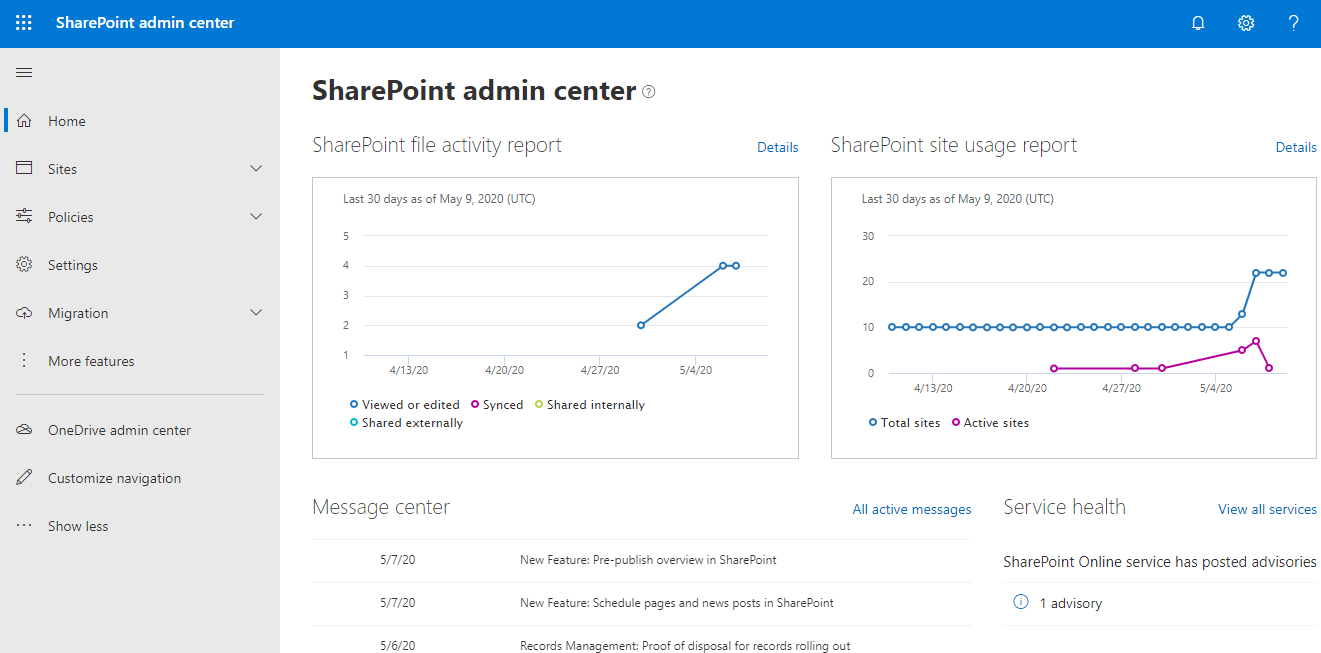
Sharepoint file activity report
Sharepoint file activity report shows a graphical representation of file activities such as viewed or edited, synced, shared internally and shared externally. You will get the report for 7 days, 30 days, 90 days, and 180 days interval based on Files. Pages and Users
Sharepoint site usage report
Sharepoint site usage report provides details for total and no active sites over the period of 7 days,30 days, 90 days, and 180 days in graphical representation. Similarly for total no of files and no of active files over the period of same days interval. Provides details on storage used and page views in the same period of days
Message center
Shows each message gives you a high-level overview of a planned change and how it may affect your users and links out to more detailed information to help the administrator prepare the action plan.
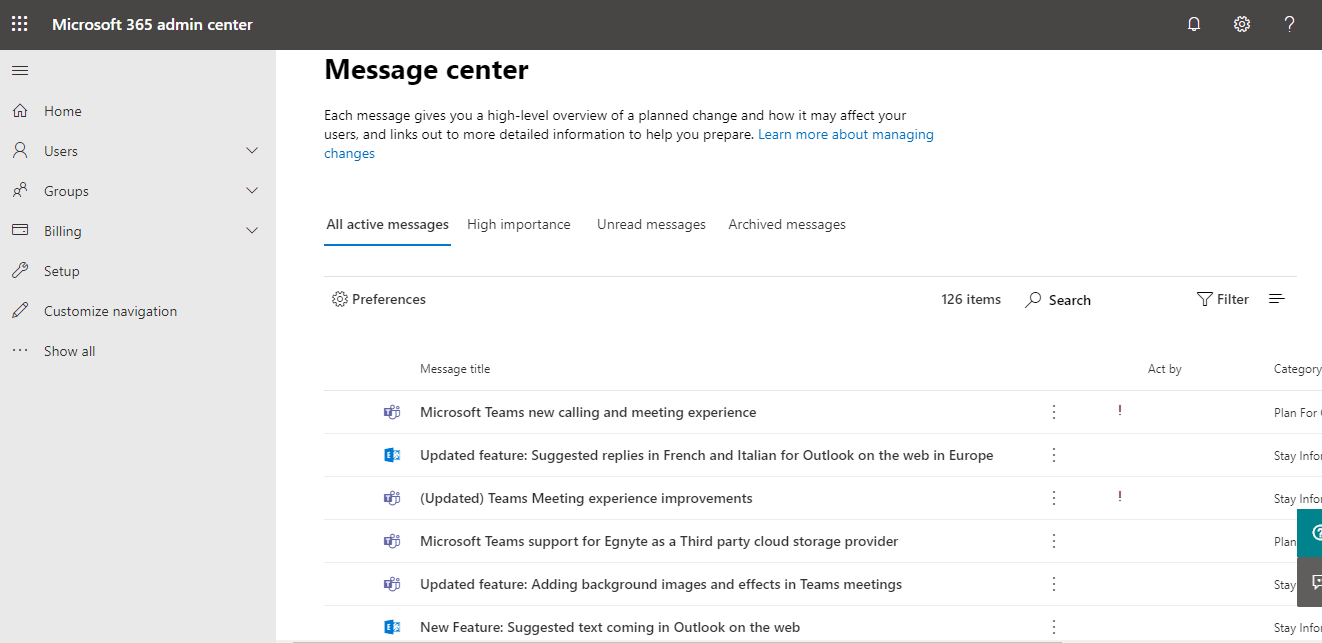
Service health
Service health provides current information on service health activity for all Microsoft 365 services. Shows any failure incidents, past history of issues occurred, recommended advisory taken, and reported status by the administrators.
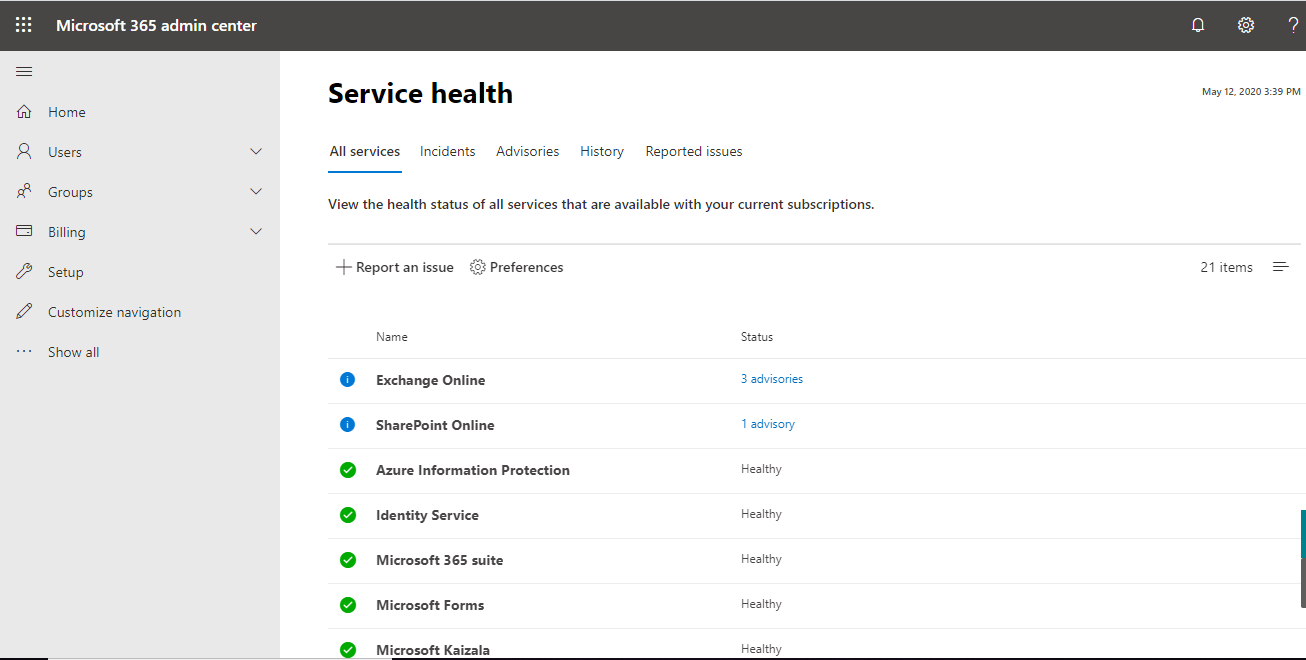
Sites – Active Sites & Deleted Sites
Active Sites
Active Sites shows all the SharePoint sites hosted in your tenant by the Administrators or by the Group owners. This page shows all the information of each site such as Name of the site, Site URL, storage used for a particular site, and who is the primary admin of each site.
You can also create a SharePoint site by clicking the + sign on this page. You have the option to create a Team site or communication site.
Team site
Share documents, have conversations with your team, keep track of events, manage, manage tasks, and more with a site connected to an Office365 group.
Communication site
Publish dynamic, beautiful content to the people in your organization to keep them informed and engaged on topics, events, or projects.
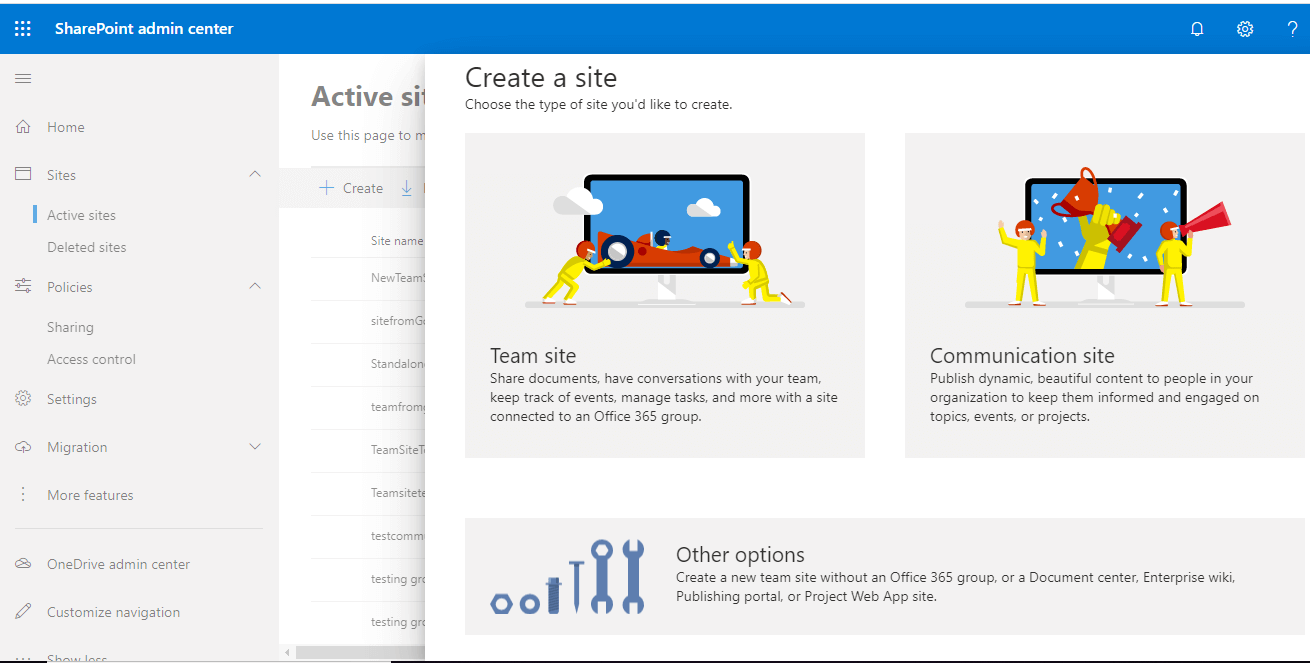
Deleted Sites
Shows the deleted SharePoint sites in your organization with all the details such as site URL, storage used, primary admin name and the template used, and date & time of site creation and deletion. By default, sites are retained for 93 days, and then permanently deleted.

Policies
Use these settings to control sharing at the organization level in SharePoint and OneDrive
Sharing
This has two settings applying on the Sharepoint site sharing. External sharing & File and folder links.
External sharing
Administrators can set external sharing permissions from Most permissive level to least permissive level, by hovering the levels. Currently, there are four permissive levels viz
- Anyone – Users can share files and folders using links that don’t require a sign in. process
- New and existing guests – Guest must sign in or provide a verification code
- Existing guests – Only guests already present in your Organization directory
- Only people in your organization – No external sharing allowed
You can further restrict sharing for an individual user at the site level
More external sharing settings
- Limit external sharing by domain – You can restrict site sharing by the domain name. When enabled, administrators can add domains to either allow or block the domain users for sharing. So administrators can allow any external domain for sharing or block any external domain for sharing.
- Allow only users in a specific security group to share externally – When enabled, administrators can add a security group to share external domain users. If administrators allow a security group to share by using Anyone links, users in that group can also share with guests who authenticate
- Guest must sign in using the same account to which sharing invitations are sent
- Allow guests to share items they don’t own
- People who use a verification code must reauthenticate after this many days – When enabled administrator should provide no of days. By Default 30 days, after that user has to re-authenticate to access the SharePoint link.

File and folder links
Choose the type of that selected by default when users share files and folders in Sharepoint and OneDrive.
- Specific people ( only the people, the sharing user specify )
- Only people in your Organization
- Anyone with the link.
You can choose any one of the options above. By default “Anyone with the link “ is selected.
Choose the permission that’s selected by default for sharing links. – When a user sharing a link, the default permissions to be added for the shared users. Sharing user can specify either View or Edit permission for the link. Here the administrator can set this permission to either selecting View or Edit option.
Choose expiration and permissions options for Anyone Links
When Anyone with the links is enabled for File and folder links above, additional settings such as no of days for link expiry, and link permission for file & folders have to be specified by the administrator as in the shown image.
When enabled, the administrator should provide a no ( of days ) in the provided box for the link expiry. And he should select any of the options: View or View and edit for files and folders permissions separately
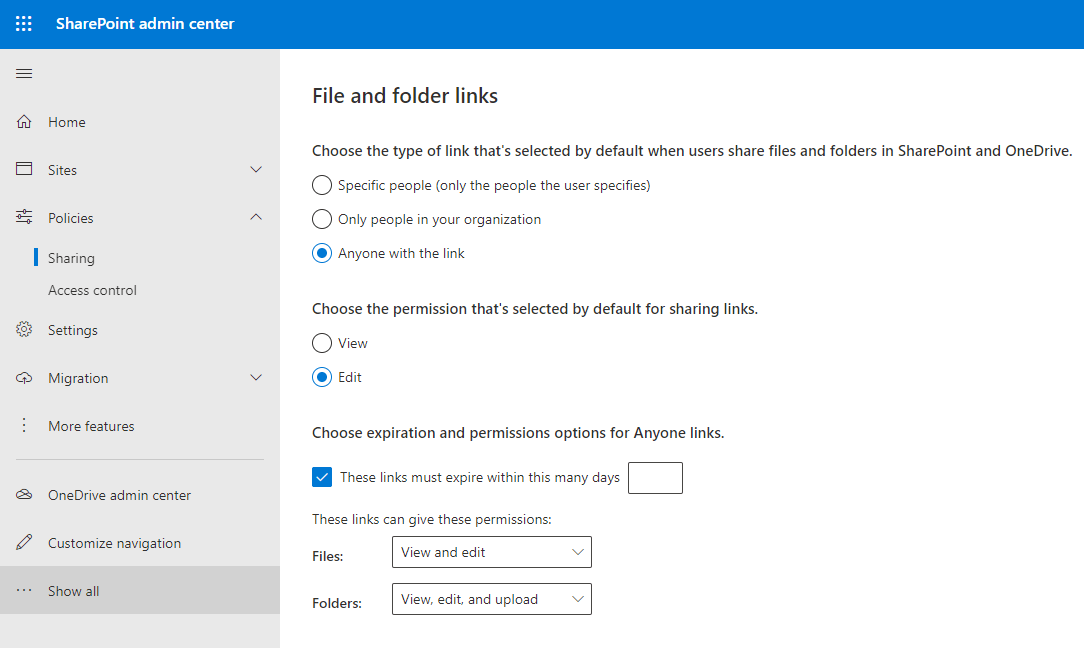
Other settings :
Other available settings can be enabled or disabled are :
Show owners the names of people who viewed their files in OneDrive.
Let Site owners choose to display the names of people who viewed files or pages in SharePoint
Use short links for sharing files and folders.
After changing any of the above settings in the Sharing page, Click Save to proceed.
Access control
Use these settings to restrict how users are allowed to access content in SharePoint and OneDrive. It has four settings to allow or restrict access for external users SharePoint access.
Unmanaged devices
Restrict access from devices that are not compliant or not joined to a domain – You can protect your organization information from unauthorized access by getting a subscription of Enterprise Mobility + Security and assign a license to the shared user for valid and secure access.
Idle session timeout
Warn and then sign out the users on unmanaged devices after a period of inactivity. This settings apply when users don’t select to sign in. Administrators can set ON and OFF this setting on this page.
Network location
Use this setting to allow access only from the IP address the company owns. Administrators can ON and OFF this settings based on their requirements.
Apps that don’t use modern authentication
Some third-party Apps and older versions of Office can’t enforce device-based restrictions. Use this settings to block all access from these apps. Administrators can choose to Allow access or Block access depending on their requirements . Prior to Office 2010 are considered as not using modern authentication
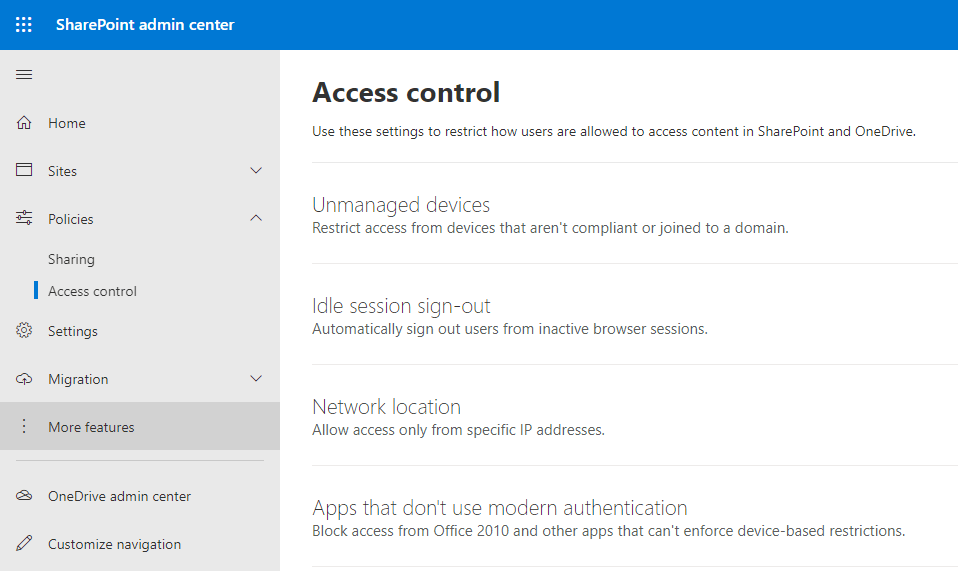
Settings
These settings are related to SharePoint general appearance,storage settings, and notification settings
Default admin center
In the new SharePoint admin center, you can manage both modern and classic sites. You can also manage the latest features and access all the classic features. Select the admin center you want to open by default for all admins. He can choose either the New Sharepoint admin center or the Classic Sharepoint admin center.
Pages
Modern pages are easy for users to design and publish, and are built to look great on any device. Administrators can enable two settings here. Can enable or disable “Allow users to create new modern pages on sites that don’t already have site pages”. Can enable or disable “Allow commenting on modern pages”
SharePoint notifications
When this setting is on, and users turn on notifications in Office mobile apps, they’ll receive notifications about SharePoint content. Administrators can enable or disable the “ Allow notification” setting.
Site creation
These settings allow users to create Sites from the SharePoint MainPage and OneDrive.
You can also set the URL for team creating sites and their default timezone.
Site storage limits
Share storage among all sites, or control storage limits by the site. This can be Automatic or Manual
Automatic – Let sites use as much of your Organization’ storage as they need.
Manual – Set specific limits for each site.
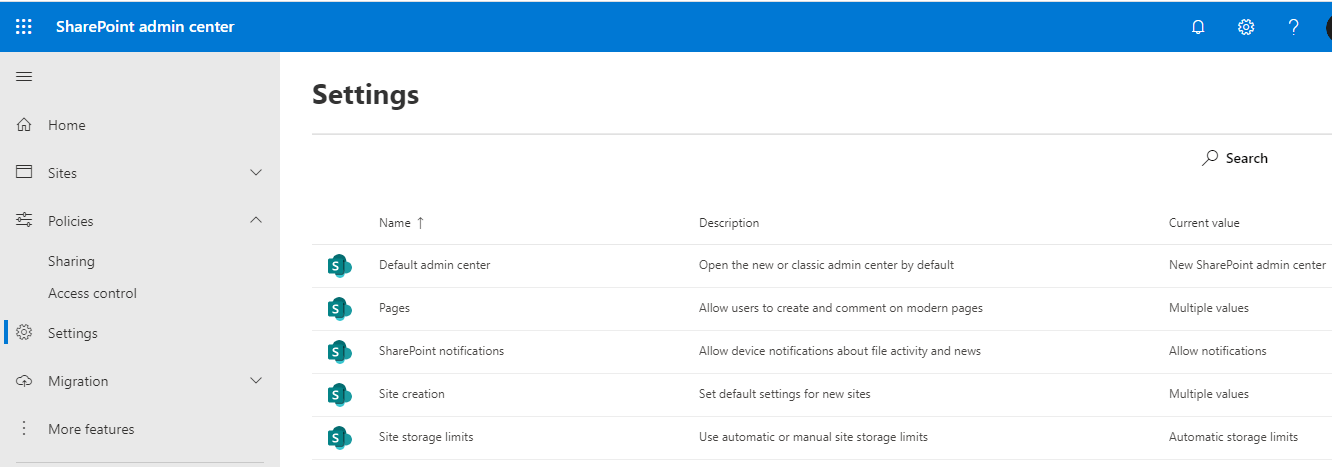
Migration
A SharePoint migration is a process of taking all the content you have in your existing file share or lower version of SharePoint or any third party file share applications ( either cloud or on-premise ) and moving it to either a new or an existing environment. Generally, it’s to a newer version, such as SharePoint Online.
Sharepoint Admin center supports three types of Migration – 1. Using Migration Manager 2. Desktop tool and 3. Cloud content migration.
1. Migration manager
The Migration Manager helps Administrator manage enterprise-scale migrations of network file shares to Microsoft 365. This involves two-step. Installing the agent on each Windows computer or virtual machine where the files share reside and create tasks to start the migration.
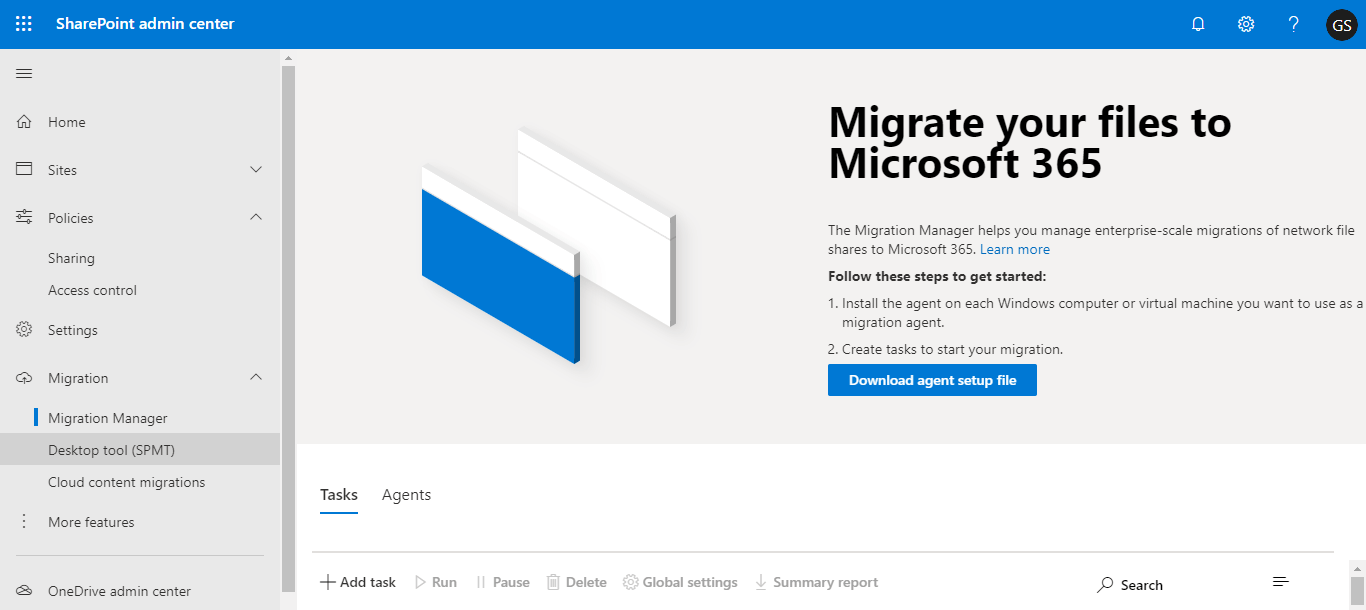
2. Desktop Tool ( SPMT ) SharePoint migration tool –
The SharePoint Migration Tool (SPMT) lets you create and manage your migration tasks from a single computer or VM. For large file share migrations spanning multiple computers or VMs use Migration manager.
SPMT is best for:
- Moving content from SharePoint Server 2010 or SharePoint Server 2013
- File share migration from a single computer or VM
- Migrating content to SharePoint Online, OneDrive and Teams
3. Cloud content migration :
Supports third party file share migration, such as
- Amazon WorkDocs
- Box
- Dropbox
- Egnyte
- Google Drive
All these third party migrations are managed by Mover acquired by Microsoft recently.
More features
Some of the features and tools available in the classic Sharepoint Admin Center are listed below.
Term store – Create and manage term sets to help users enter data consistently
User profiles – Add and remove admins for a user’s OneDrive, disable OneDrive creation for some users, and more.
Search – Help users find what they’re looking for.
Apps – Configure SharePoint Store settings, monitor app usage, manage app licenses, and more.
BCS – Manage connections to data sources like Azure SQL databases or WCF web services.
Secure store – Create and set the credentials for Target Applications used for BCS connections.
Records management – Manage records in a Records Center site that serves as an archive.
Infopath – Enable browser-based InfoPath forms.
Hybrid picker – Use this tool wizard to automate some of the steps in setting up a hybrid environment.
Classic site collections page – View the list of classic site collections in alphabetical order by URL.
Conclusion :
For any Microsoft Office365 Administrator, and IT support engineer in an Organisation, knowledge of SharePoint is a must, and he can do creating, managing sites every day. Knowing Microsoft 365 Sharepoint Admin center is a first step, for understanding all features and services offered by Microsoft, and implementing all the requirements on his Organization SharePoint project is a secure and effective way.
Download BDRSuite Backup for Microsoft Office 365 and Protect your Office 365 Data!
Download the full-featured 30-day free trial of our latest version BDRSuite and experience modern data protection for your Office 365 environment.
- Backup your Mails, Contacts, Calendars, and OneDrive items
- Recover data anywhere and anytime
- Restore domain or user-level data
- Store your data on-premise or in BDRCloud
Learn more and get started with BDRSuite Backup for Microsoft Office 365
Follow our Twitter and Facebook feeds for new releases, updates, insightful posts and more.



Leave A Comment